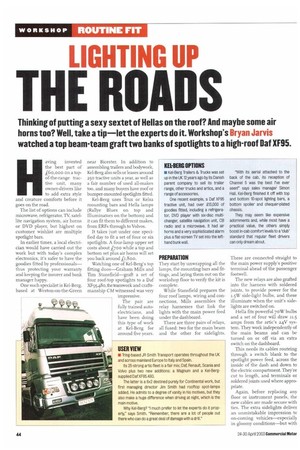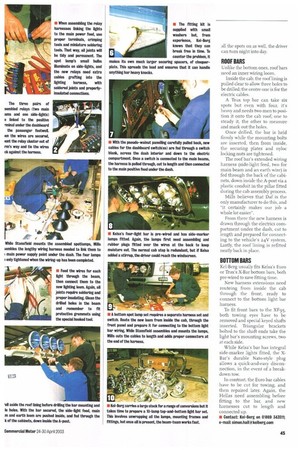T E ROADS
Page 44

Page 45

If you've noticed an error in this article please click here to report it so we can fix it.
Thinking of putting a sexy sextet of Hellas on the roof? And maybe some air horns too? Well, take a tip—let the experts do it. Workshop's Bryan Jarvis watched a top beam-team graft two banks of spotlights to a high-roof Oaf XF95.
H aving invested
the best part of f6o,00o on a topof-the-range tractive unit, many owner-drivers like to add extra style and creature comforts before it goes on the road.
The list of options can include microwave, refrigerator, TV, satellite navigation system, air horns or DVD player, but highest on customer wishlist are multiple spotlight bars.
In earlier times, a local electrician would have carried out the work but with today's complex electronics, it's safer to have the goodies fitted by professionals— thus protecting your warranty and keeping the insurer and bank manager happy.
One such specialist is Kel-Berg, based at Weston-on-the-Green near Bicester. In addition to assembling trailers and bodywork, Kel-Berg also sells or leases around 25o tractive units a year, as well as a fair number of used all-makes too, and many buyers have roof or bumper-mounted spotlights fitted.
Kel-Berg uses Tn.ix or Kelsa mounting bars and Hella lamps (Rallye Blues on top and Illuminators on the bottom) and it can fit them to different makes, from ERFs through to Volvos.
It takes just under one specified day to fit a set of four or six spotlights. A four-lamp upper set costs about L700 while a top and bottom set plus air horns will set you back around i,800.
Watching one of Kel-Berg's top fitting duos—Graham Mills and Tim Stansfield—graft a set of four roof-top spotlights to a Daf XF95480, the teanwork and craftsmanship CM witnessed was very
impressive.
The pair are fully trained autoelectricians, and have been doing this type of work at Kel-B erg for around five years. PREPARATION They start by unwrapping all the lamps, the mounting bars and fittings, and laying them out on the workshop floor to verify the kit is complete.
While Stansfield prepares the four roof lamps, wiring and connections, Mills assembles the relay harnesses that link the lights with the main power feed under the dashboard.
There are three pairs of relays, all fused: two for the main beam and the other for sidelights.
These are connected straight to the main power supply's positive terminal ahead of the passenger footwell.
The new relays are also grafted into the harness with soldered joints, to provide power for the 1.5W side-light bulbs, and these illuminate when the unit's sidelights are switched on.
Hella fits powerful 70W bulbs and a set of four will draw 11.5 amps from the artic's 24V system. They work independently of the main beams and can be turned on or off via an extra switch on the dashboard.
This needs its cables routeing through a switch blank to the spotlight power feed, across the inside of the dash and down to the electric compartment. They're cut to length, and terminals or soldered joints used where appropriate.
Again, before replacing any floor or instrument panels, the new cables are made secure with ties. The extra sidelights deliver an unmistakable impression to on-corning vehicles—especially in gloomy conditions—but with all the spots on as well, the driver can turn night into day.
ROOF BARS
Unlike the bottom ones, roof bars need an inner wiring loom.
Inside the cab, the roof lining is pulled clear to allow three holes to be drilled; the centre one is for the electric cables.
A Trux top bar can take six spots but even with four, it's heavy and needs two men to position it onto the cab roof; one to steady it, the other to measure and mark out the holes.
Once drilled, the bar is held firmly while the mounting bolts are inserted, then from inside, the securing plates and nyloc locking nuts are tightened.
The roof bar's extended wiring harness (side-light feed, two for main beam and an earth wire) is fed through the back of the cabinets, down inside the A-post via a plastic conduit in the pillar fitted during the cab assembly process.
Mills believes that Daf is the only manufacturer to do this, and "it certainly makes our job a whole lot easier".
From there the new harness is drawn through the electrics compartment under the dash, cut to length and prepared for connecting to the vehicle's 24V system. Lastly, the roof lining is refitted neatly back in place.
BOTTOM BARS
Kel-Berg usually fits Kelsa's Euro or Trux's X-Bar bottom bars, both pre-wired to save fitting time.
New harness extensions need routeing from inside the cab through the front, ready to connect to the bottom light bar harness.
To fit front bars to the XE'95, both towing eyes have to be removed and special keyed shafts inserted. Triangular brackets bolted to the shaft ends take the light bar's mounting screws, two at each side.
While Kelsa's bar has integral side-marker lights fitted, the XBar's durable Nato-style plug allows a quick-and-easy disconnection, in the event of a breakdown tow.
In contrast, the Euro bar cables have to be cut for towing, and then repaired later. Again, the Hellas need assembling before fitting to the bar, and new harnesses cut to length and connected up.
• Contact: Kel-Berg on 01969 343511; e-mail: simen.hallakelberg.com
































































































































































